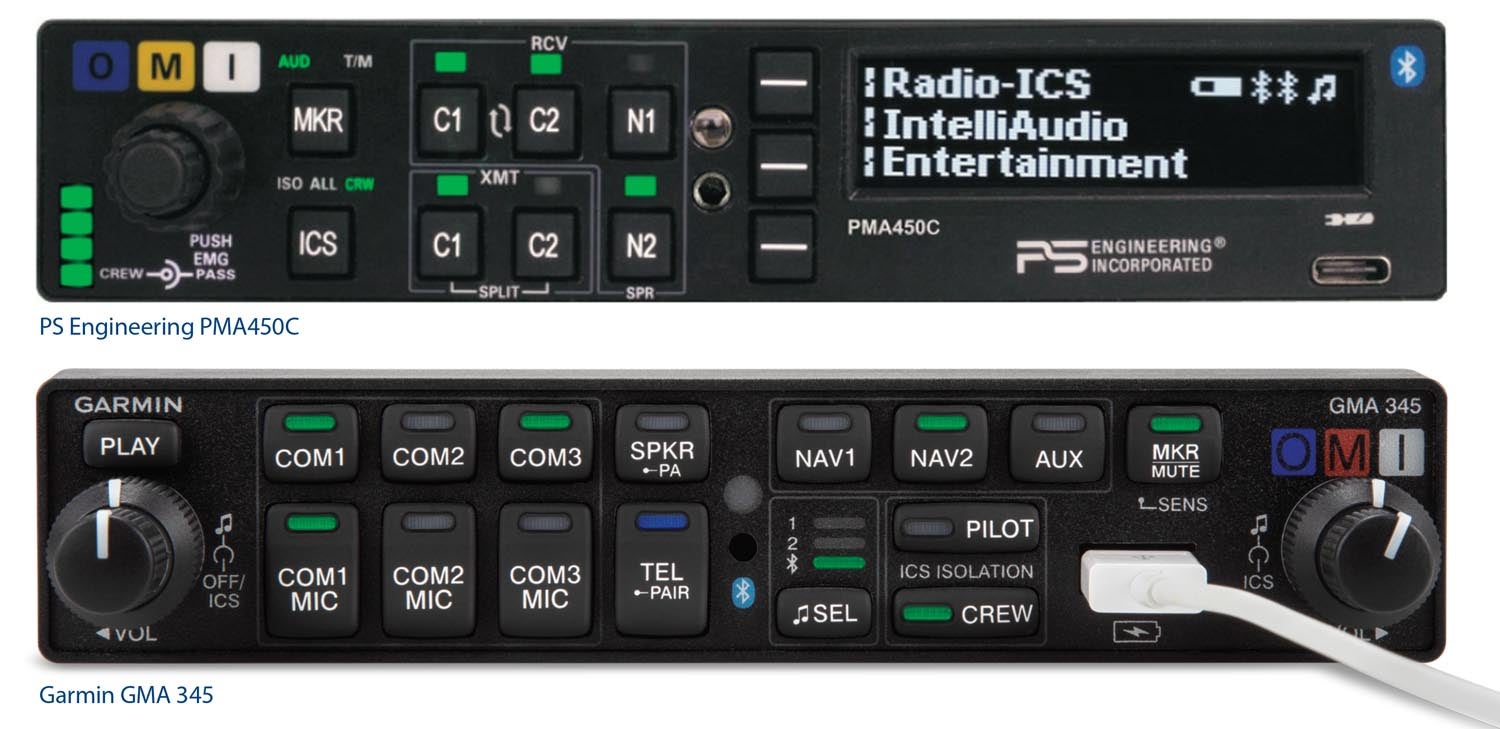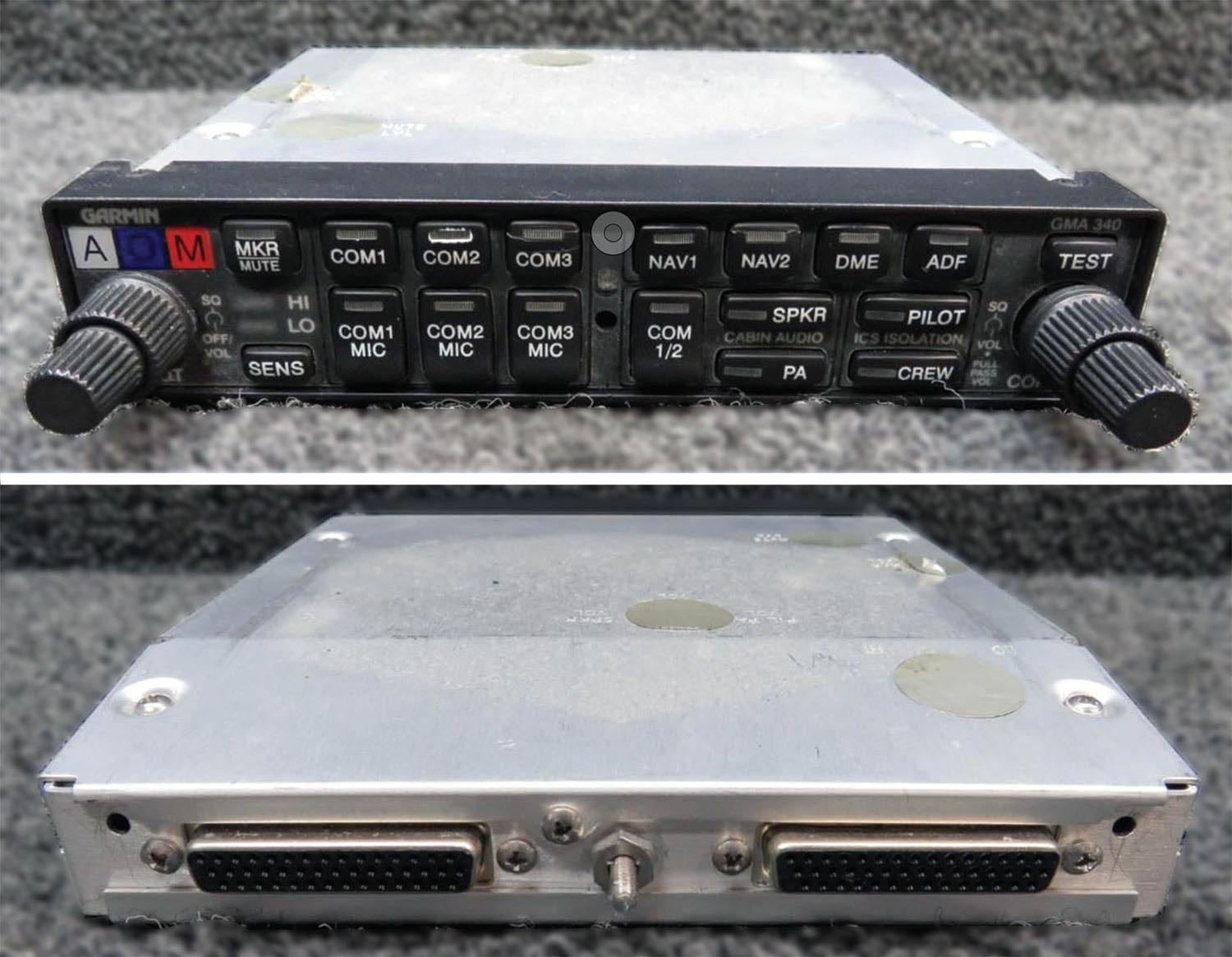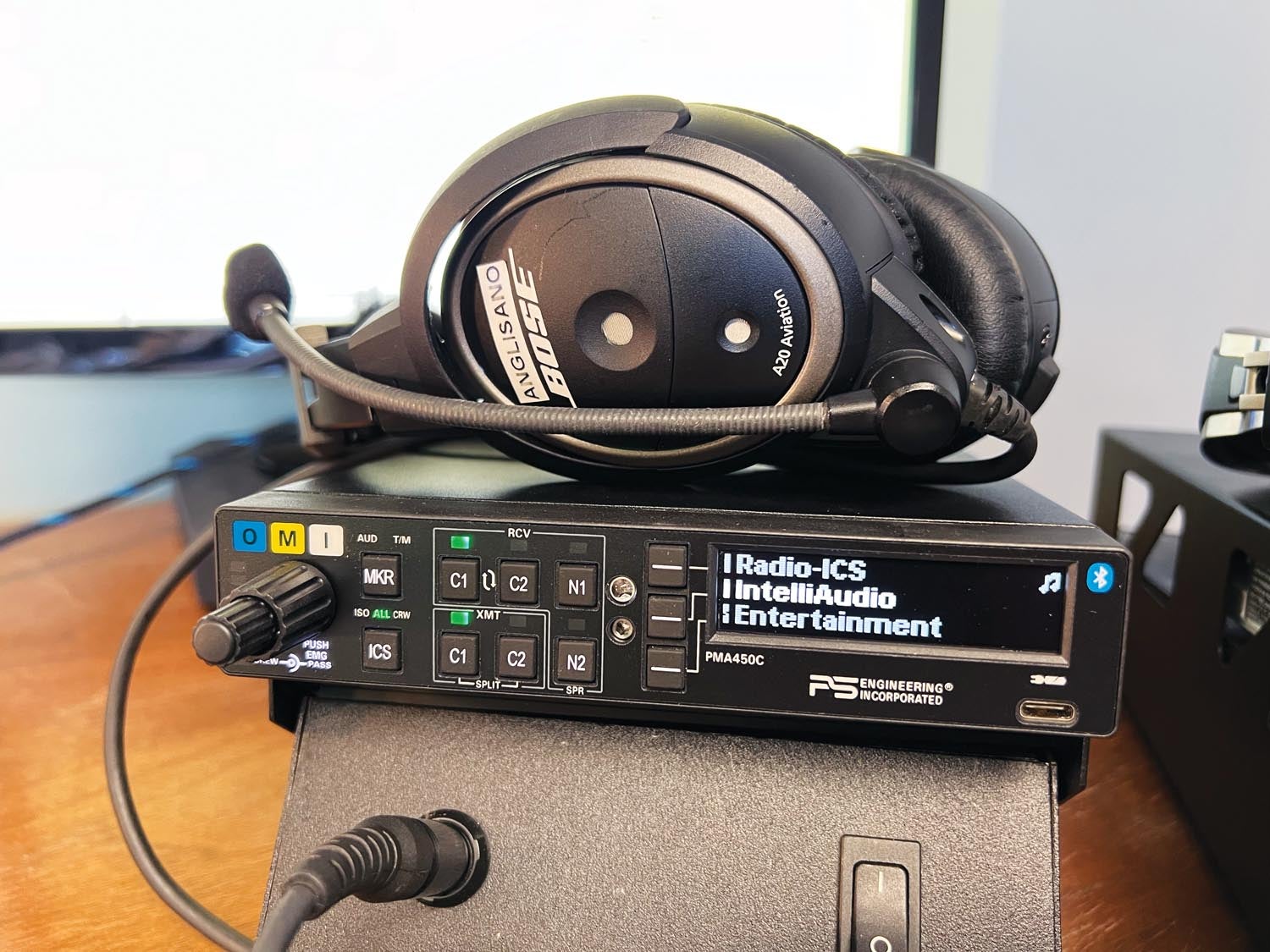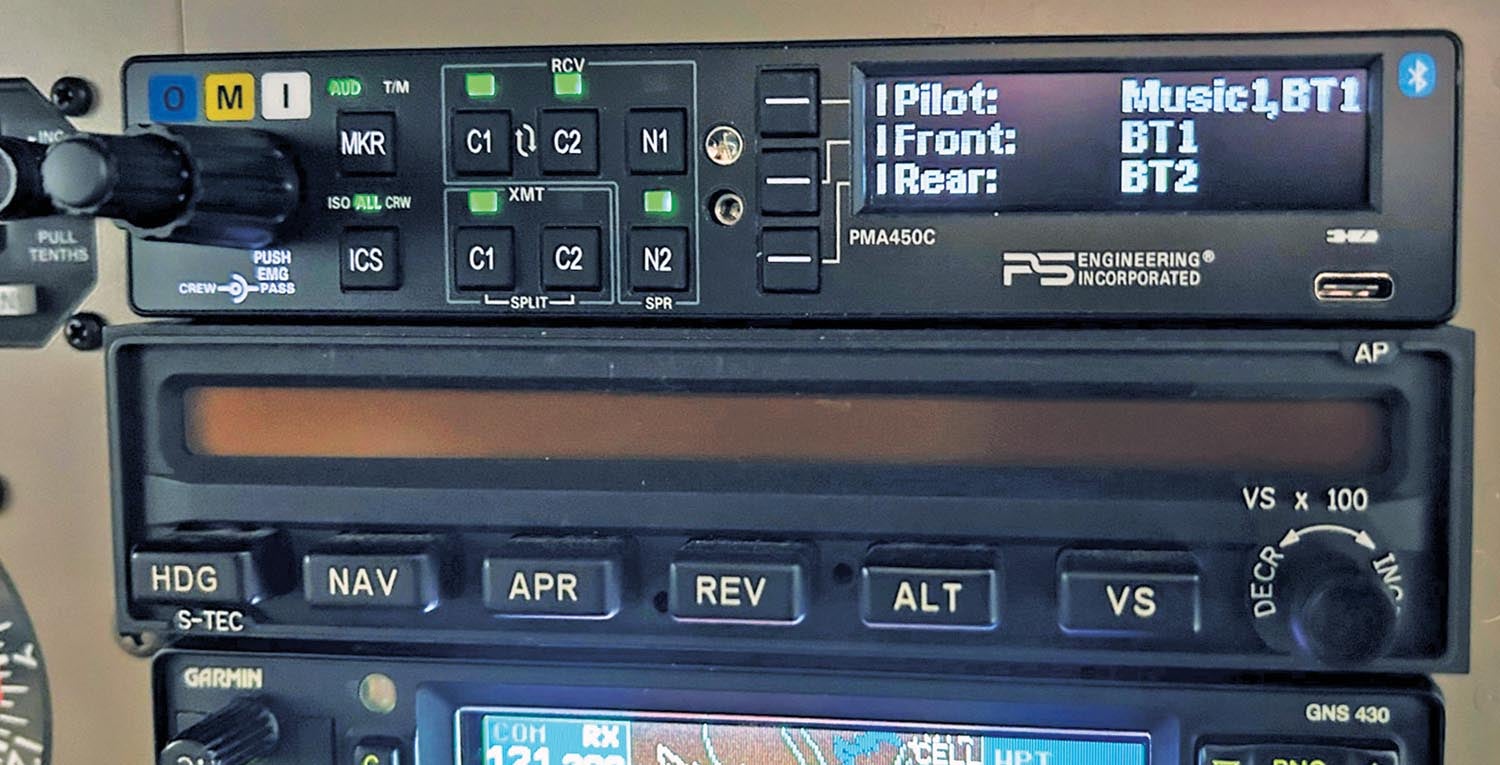 Tens of thousands of Garmin GNS 430 and 530 navigators were paired with Garmin’s GMA 340 audio panel—a generally good, reliable audio system with built-in intercom and wired entertainment input. But late last year, Garmin announced (via Service Advisory 21115, Rev. C) that popular flavors of the GMA 340 have reached the end of their service life. While it’s been a long run, that means a lot of owners could be looking for replacement panels when their GMA 340 needs major service.
Tens of thousands of Garmin GNS 430 and 530 navigators were paired with Garmin’s GMA 340 audio panel—a generally good, reliable audio system with built-in intercom and wired entertainment input. But late last year, Garmin announced (via Service Advisory 21115, Rev. C) that popular flavors of the GMA 340 have reached the end of their service life. While it’s been a long run, that means a lot of owners could be looking for replacement panels when their GMA 340 needs major service.
The good news is there are a couple of worthy slide-in replacement units (in many cases, no new wiring is required) from Garmin and PS Engineering that bring more modern tech and more features than the aging GMA 340. In this short report, we’ll take a look at the options. These new panels bring so many advanced standard functions that we can’t cover their entire feature sets in one article, so we’ll touch on major features to help with your buying decision.
Garmin GMA 345
This isn’t exactly a new panel, introduced around five years ago, but it has plenty of modern features including Bluetooth and Garmin’s 3D Audio. More on that in a minute. Based on the GMA 340 chassis, the $2245 GMA 345 has a six-place intercom (although most Experimental kits don’t have that many seats), but if your GMA 340 is wired for fewer ICS stations, the 345 will play in the interface just as the old unit did.
I’ve always liked the GMA 340’s rugged buttons and control knobs, and the GMA 345 continues the tradition. Plus, it has good bezel and key lighting. Like the 340, when a key is selected, a green annunciator shows that the function is active, and you can control the brightness with the aircraft’s dimmer system.

For basic audio (VHF radio) switching and intercom volume control, the GMA 345 operates a lot like the old GMA 340. The left inner rotary knob serves double duty as an on/off control and pilot intercom volume control. The left outer knob controls the pilot’s music volume. On the other side of the bezel, the inner knob controls the copilot and passenger intercom volume, while the right outer knob controls the copilot and passenger music volume. But there’s a lot more to the panel, especially compared to the GMA 340. The GMA 345 has no fewer than 18 bezel controls and many have alternate key functions, which means one button performs more than one action.
Here are some examples of the alternate key functions related to Bluetooth music: Simultaneously pressing the Nav2 and Music keys is how you play and pause the connected Bluetooth media. The Nav2 and Aux1 keys are used to skip the previous music track. Keep the pilot’s guide handy because you’ll need it to get the button-pushing right, at least until you learn the control set. Garmin includes a laminated quick-reference card that focuses on alternate key functions.
Bluetooth, Recorder, 3D Audio
The GMA 340 came out long before the age of cockpit Bluetooth, but the newer GMA 345 supports the A2DP Bluetooth profile for entertainment audio input (and AVRCP for advanced audio controls like play/pause, skip forward/previous), plus the HFP Bluetooth for connecting a telephone. When the telephone is connected, you talk in full duplex through the headset, and the panel also has Bluetooth telephone volume controls. There’s also a Type A USB jack on the panel’s bezel for charging (2.1 amps max) devices.
GMA 340 users will notice overall better audio quality from the GMA 345 thanks to Garmin’s built-in ASQ, for Avionics Squelch. This circuitry filters out some of the noise that tags along with VHF com radios. But don’t use the ASQ as a Band-Aid for poor wiring. And for tweaking the music quality, the set has a music equalizer feature where you can select classical, pop or rock genres, plus there’s a medium and high Music Bass Boost (or you can turn off entirely) for boosting the low-end frequency. Paired with decent stereo ANR headsets, I think the GMA 345 shines and it’s a lot better than the analog (wired) entertainment input circuit on the old GMA 340.
Another feature the 345 has over the 340 is a decent 60-second clearance recorder, where it records the selected com radio (in separate memory blocks) and you play it back using the Play key. Once the 60 seconds of storage is spent, the system records over the memory blocks, starting from the oldest one. Toggle through the stored recordings by subsequently pressing the Play key. To stop the playback, press the MKR/MUTE key.

The 3D Audio feature in the GMA 345 spatially processes the audio in a specific location in the cabin. In a two-com setup, the primary radio is processed at the 11 o’clock position and the second com is heard at the 1 o’clock. Don’t confuse this with the Garmin Telligence voice command feature that’s in the GTN 750 navigator. Telligence works with Garmin’s GMA 350 series panels and not the GMA 345. And for the Telligence to work, you need stereo headsets and stereo audio jacks—hardware that might not be present in a GMA 340 installation. You don’t have to use the 3D Audio feature—turn it on or off as you wish.
The GMA 345 supports up to four unswitched audio inputs, so you can wire in various alerts for engine, landing gear, traffic systems and other attention-getting items. The GMA 345 is available without Bluetooth for $2045, but I think the Bluetooth version is a better value given the functionality.
PS Engineering
The company has been offering slide-and-fly options for Garmin’s GMA 340 for years, and the latest is the $2595 PMA450C. A version without marker beacons is available for $100 less. The PMA450C (with a six-place intercom with three isolation modes) is actually the third generation of the 450 series, and PS Engineering has been offering it as a lower-cost alternative to the flagship PMA450B, with a couple of scaled-back features that some users wouldn’t use anyway. This helps PS Engineering conserve in-demand microchips and also control costs. But the PMA450C and 450B are certainly cut from the same cloth.

Forget everything you know about Garmin’s alternate key feature set when using the PMA450. It uses an OLED graphical bezel display with a three-softkey user interface—something I think can benefit the Garmin unit. Because of this intuitive function display, PS Engineering says most users should be able to operate the panel without flipping through the user’s manual. I think the shallow menu structure does a good job of leading the user through primary functions and advanced custom configurations on the fly. And if Bluetooth music and tablet app audio alerts are high on your list of must-haves, the PMA450 series excels. For starters, it has dual Bluetooth modules, which means you can simultaneously connect the panel to an iPhone and an iPad. There’s a lot of utility there because maybe the iPad is running your favorite cockpit app (and streaming audio output alerts) and the iPhone is streaming your tunes.

For music streaming, there are four possible independent entertainment inputs, including Bluetooth 1, Bluetooth 2 and two wired inputs. Wired music isn’t dead—yet. Maybe you want to plug in a patch cable from a music device or a laptop into a cabin audio jack, or maybe hardwire a remote SiriusXM receiver for satellite music. Like the Bluetooth sources, these inputs are all configurable so they mute (or not) when there’s com radio and intercom chatter.
And when it comes to configuring all those input sources, the 450 series shines. The function display’s dedicated Entertainment line menu offers three choices for Mute mode, Distribution mode and also a setting for Music Volume. Choose your configuration: BT1, BT2, BT1 and BT2, wired Music 1, BT1 and Music 1, or to keep it simple, just BT 1 for a single Bluetooth input. It’s an incredibly flexible Bluetooth feature set. The advantages of all these configurations are obvious for larger cabins with multiple passengers who might want to listen to their own custom Bluetooth sources.
For the typical two- or four-seat homebuilt, there’s obviously more configurations than many will use, but I think it’s useful to have, especially when you want to easily isolate a nervous passenger from hearing tablet app alerts. Moreover, PS Engineering makes it easy to configure so only the pilot hears startling audio alerts from an iPad or smartphone. In fact, when it comes to options for streaming those devices, there are an impressive 27 different input source and muting options available from the on-screen menu.

IntelliAudio, Recorder
Similar in concept to Garmin’s 3D Audio, PS Engineering’s IntelliAudio (originally licensed from the U.S. Air Force) allows the user to digitally position the com radios in separate positions in the headphone. In the PMA450C, the function is slightly scaled back from the flagship PMA450B, where the user can select up to nine unique spatial positions (this is called HRTF, for head related transfer function), configurable using the graphics on the display. In the PMA450C it’s simplified, and activating IntelliAudio places com radio 1 in the 10 o’clock and com 2 in the 2 o’clock positions—probably sufficient for many users and potentially useful for those with hearing loss.
Also a help for those with hearing issues is the standard recording function that stores the incoming com radio audio from the one you’re transmitting on. It’s pretty simple to use and a good backstop for getting ATC instructions correct the first time. Simply press and hold the com receiver push-button that’s associated with the radio you’re transmitting on for the recorder’s playback. And if you fly with an action cam, PS Streamer is a built-in audio module that streams Bluetooth audio out of the panel. It’s compatible with some GoPro models and is useful for including cockpit audio in a video production or for training purposes.
A feature that’s been taken out of the budget-minded PMA450C that’s standard in the 450B is Flightmate. It enables a handful of discrete and configurable messages (up to four) that are triggered from externally connected systems. Systems like landing gear and engine monitors that output the correct signals—JP Instruments and Electronics International engine displays are two that are compatible—can be wired in, and in the 450B, you can even record your own alerts in your own voice by speaking them into the microphone. “Check fuel,” “Check gear” and “Check speed brakes” are a few. If these features are worth it to you, the PMA450B is priced at $2895 with marker beacons and $2795 without markers.
PMA8000G
The $2095 ($1995 without marker beacons) PS Engineering 8000 series has been in the company’s lineup for years, and it has made useful improvements and tweaks along the way. Expect high-quality audio quality thanks to PS Engineering’s proven IntelliVox automatic voice activation with individually gated microphones. The third-gen 8000G interface has advanced digital processing and PS Engineering’s Flightmate that’s standard on the flagship PMA450B. It also has IntelliAudio as standard, which works like it does in the PMA450C, placing com radio 1 in the 10 o’clock and com 2 in the 2 o’clock positions. There’s also a 10-watt bezel-mounted USB charging port.

The Bluetooth-equipped, six-place-intercom PMA8000G certainly isn’t without PS Engineering’s feature-rich interface. It has three music input modes, four unswitched inputs, selectable music distribution for passengers and a smart cellphone interface. And like the 450 series, the Bluetooth in the PMA8000G can be configured so only the pilot hears audio alerts from a connected tablet or smartphone running an aviation app like ForeFlight, Garmin Pilot and others.
While the PMA8000G is a savings over the PMA450C, for many I think the extra $500 is worth it for the bezel display. It just makes configuring the Bluetooth and other advanced functions so much easier.
Get a Demo
Like most all advanced avionics, I think a hands-on demo is in order before buying any of these slide-in audio panels. They all do so much more (and they do it well) than Garmin’s stark-by-comparison GMA 340. Paired with a high-quality ANR headset, all of these panels (when wired properly) will offer exceptional audio quality that’s notably better than the old GMA 340. If I had to pick one, I favor the PMA450C because the advanced feature set—and the ability to easily customize the settings—is simplified with the bezel display.
Photos: Courtesy of Garmin, PS Engineering and Larry Anglisano













